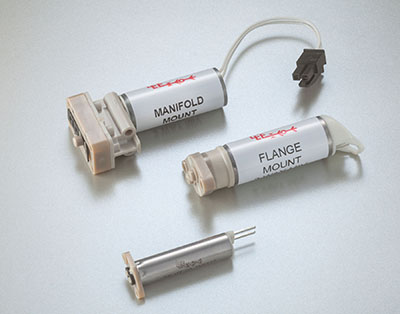 A solenoid valve is an electrically activated valve, typically used to control the flow or direction of air or liquid in fluid power systems. Solenoid valves are used in both pneumatic and hydraulic fluid power systems, and most often in either poppet or spool configurations.
A solenoid valve is an electrically activated valve, typically used to control the flow or direction of air or liquid in fluid power systems. Solenoid valves are used in both pneumatic and hydraulic fluid power systems, and most often in either poppet or spool configurations.
The spool or poppet of the valve is connected to a ferrous metal plunger, which is typically spring centered or spring offset. The plunger slides within a core tube of non-ferrous metal, which itself is surrounded by a coil of electrical windings. The coil can exist as any range of voltage from 12-48 V dc to 110-220 V ac. When power is sent through the coil, a magnetic field is created that pushes or pulls the plunger, shifting the valve.
The most basic solenoid valves are two-way, two-position poppet valves, which simply open and close to allow flow when their coil is energized. They are available as “normally-open” and “normally-closed” versions, which means normally-flowing and normally-blocked, respectively. Normally-open in fluid power is the opposite of normally-open in electronics, which means the switch or contact is open and not flowing electrons.
Three-way, two position poppet valves are also common, allowing fluid to be diverted from one channel to another. Two 3/2 valves in parallel can be used to control and cylinder bi-directionally. Although construction varies depending on the use, this type of valve can be used for either pneumatics or hydraulics.
Spool solenoid valves consist of a machined spool that can slide within a machined valve body. Each end of the spool can have a plunger attached, allowing the solenoid valve to be pushed in either direction, allowing three positional envelopes. The 4/3 hydraulic solenoid valve is one of the most popular, allowing for bidirectional control of a cylinder in a single valve body. The “ways” of a solenoid valve refer to how many ports it contains, and the “positions” of a solenoid valve refer to how many states it can operate within. A three position valve requires a spring centered neutral state along with two actuated positions.
Pneumatic valves are available as five ported valves, allowing for a 5/3 solenoid valve for control of cylinder applications. The ways of a pneumatic valve also include its exhaust port, to which there are usually two.
Solenoid valves for either hydraulic or pneumatic applications are available as manifold-mounted modular units, such as the pneumatic or hydraulic ISO valves. These valves contain standard mounting and porting patterns, allowing valves from any manufacturer to be installed upon the same manifold. Most often, these valves are also quite economical, and readily available “off-the-shelf.”
The coils of a solenoid valve can be had with DIN connectors, lead wires, Deutsch connectors or any other popular form of electrical connection used in fluid power and automation. Solenoid valves often have removable coils, allowing quick and easy replacement after they fail. Coils also have a wide range of application and purpose. Some are intended for the industrial environment, where atmosphere conditions are consistent. Mobile environments are much more demanding, and require coils that can both handle extreme temperature ranges and exposure to road film and salt.

Hello Paul Heney,
I have gone through your blog, it gives very good information about solenoid valves. Here you explained about two types of solenoid valves i.e. two-way, two-position poppet valves and Three-way, two position poppet valves. Can you tell me which one is more efficient in oil and gas industry?
I look forward to hearing from you.
Jose Camacho
Business Development & Sales Manager
http://www.gndsc.com
Hi Jose, I am going to try to respond to your question about which type of solenoid valve (two position or three position poppet valves are more efficient.
First of all, what, exactly, do you mean by efficient? There is some ambiguity here. One option is ‘efficient’ in terms of power consumption (measured in terms of Wattage), and the other is efficient in terms of the volume of media used (volume of compressed air of hydraulic oil?
The first case is dependent upon your coil and how long the coil is being electralised for? In the second case, this depends on the total volume within the valve body — the volume that the spool occupies, as well as how long the position is held for?
I hope that helps.
Eric Lee
https://www.britishpneumatics.co.uk/
Hello,
Please my question may sound silly, but it will mean a lot to me if you answer. Here goes the question:
please can we use the same solenoid valve for both pneumatic and hydraulic system operation? I mean is the solenoid valve used in hydraulic system different from the one used in pneumatic system or solenoid valve is valve?
Thank you.